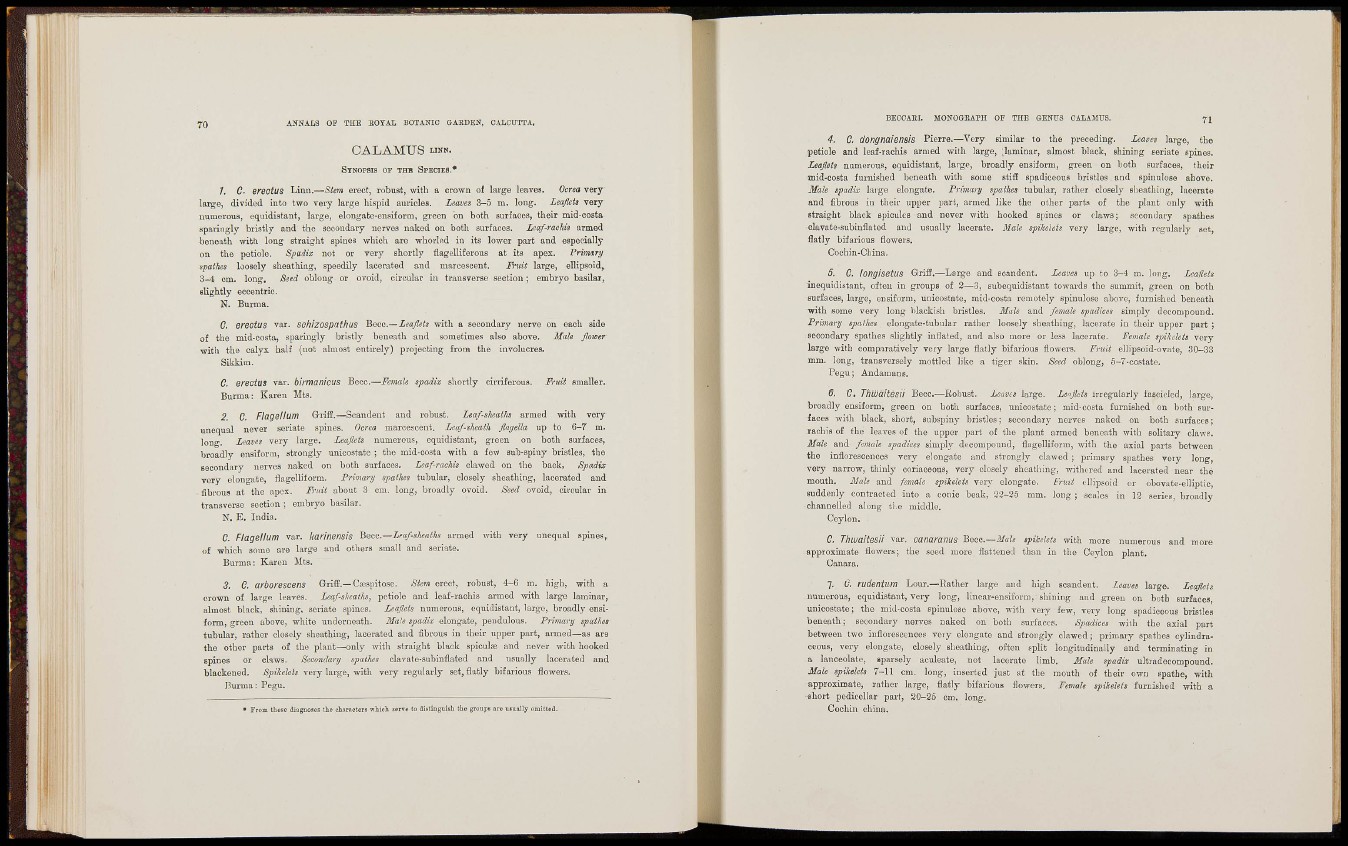
ANNAiS OF THE EOYAL BOTANIO GARDEN, OALCOTTA.
C A L A M U S LINK.
S i N o p a i s OF THB SPECIES.*
7. G. erectus Linn.—Sim erect, robust, with a crown of large leaves. Ocrea very
largo, divided into two very large hispid auricles. Leaves 3-5 m. long. Leaflets very
numerous, equidistant, large, elongafce-ensiform, green on both surfaces, their mid-costa
sparingly bristly and the secondary nerves naked on both surfaces. Leaf-rachia armed
beneath with long straight spines which are ^^'horlfid in its lower part and especially
on the petiole. Spadix not or very shortly flagelliferous at its apes. Frhmry
apathes loosely sheathiag, speedily lacerated and marcescent. Fruit large, ellipsoid,
3-4 cm. long. Seed oblong or ovoid, circular in transverse section; embryo basilar,
slightly eccentric.
N. Burma.
0. ereetus var. sohizospathus 'BGCC.— Leaflets with a secondary nerve on each side
of the mid-costa, sparingly bristly beneath and sometimes also above. Male flower
witli the calyx half (not almost entirely) pi'ojeoting from the involucres.
Sikkim.
C. ereetus var. birmanicus Becc.—Female spadix shortly cirriferous. Fruit smaller.
Burma: Karen Mts.
2 C. Flag el I um GrIS.—Scan dent and robust. Leaf-sJieaths armed with very
unequal never senate spines. Ocrea marees cent. Leaf-sheath flagella up to 6-7 m.
lona-. Leaves very large. Leaflets numerous, equidistant, green on both surfaces,
broadly ensiform, strongly unicostate ; the mid-costa with a few sub-spiny bristles, the
secondary nerves naked on both surfaces, Loaf-rachis clawed on the back, Spadix
very elongate, flagelliform. Primary spathes tubular, closely sheathing, lacerated and
fibrous at the apex. Fruit about 3 cm, long, broadly ovoid. Seed ovoid, circular in
transverse section ; embryo basilar.
N. E. India.
C. Flagellum var. karinensis 'QQC.C—Lfafsheatks armed with very unequal spines,
of which some are large and others small and seriate.
Burma: Karen Mts.
3. C. arborescens Griff.—Ciespitose. Stem erect, robust, 4-6 m. high, with a
crown of large leaves. Leaf-sheaths, petiole and leaf-rachis armed with large laminar,
almost black, shining, seriate spines. Leaflets numerous, equidistant, large, broadly ensiform,
green above, white underneath. Male spadix elongate, pendulous. Primary spaihes
tubular, rather closely sheathing, lacerated and fibrous in their upper part, armed—as are
the other parts of the plant—only with straight black spiculie and never with hooked
spines or claws. Secondary spathes clavate-subinñated and usually laccrated and
blackened. Spikelets very large, with very regularly set, flatly bifarious flowers.
Burma: Pegu.
• From these diagnojes the chaiaotera which serve to dintinguish the groups arc mually omittad.
BECCARÍ. MONOGKAPH OF THE GENUS CALAMUS. 71
4. C. dongmienais Pierre.—Very similar to the preceding. Leaves large, the
petiole and leaf-rachis armed with large, ;Iaminar, almost black, shinirig eeriate spines.
Leaflets numerous, equidistant, large, broadly ensiform, green on both sm'faces, their
mid-costa furnished beneath with some stiff spadiceous bristles and epinuloso above.
Male spadix large elongate. Primary spathes tubular, rather closely sheathing, lacerate
and fibrous in their upper part, armed like the other parts of the plant only with
straight black spicules and never with hooked spines or claws; secondary spatlies
clavate-subinflated and usually lacerate. Male spikelets very large, with regularly set,
flatly bifarious flowers,
Cochin-Clnna.
5. C. longisetus Griff.—Large and scandent. Leaves \ip to 3-4 m. long. Leaflets
in equidistant, often in groups of 2—3, subequidistant towards the summit, green on both
surfaces, large, ensiform, unicostate, mid-costa remotely spinulose above, furnished beneath
with some very long blackish bristles. Male and female spadices simply decompound.
Primary spathes elongate-tubular rather loosely sheathing, lacerate in their upjjer part ;
secondary spathes slightly inflated, and also more or less lacerate. Female spikelets very
large with comparatively very large flatly bifarious flowers. Frziit ellipsoid-ovate, 30-33
mm. long, transversely mottled like a tiger skin. Seed oblong, 5-7.costate.
Pegu; Andamans.
6. C. ThwaitesH Becc.—Robust. Leaves large. Leu flats irregularly fascicled, large,
broadly ensiform, green on both surfaces, unicostate; mid-costa furaished on both surfaces
with black, short, subspiny bristles; secondary nerves naked on both surfaces;
raehis of the leaves of the upper part of the plant armed beneath with solitary claw?.
Male and female spadices simply decompound, flagelliform, with the axial parts between
the inflorescences very elongate and strongly clawed ; primary spathes very long,
very narrow, thinly coriaceous, very closely sheathing, withered and lacerated near thé
mouth. Male and female spikelets very elongate. Fruit ellipsoid or obovate-elliptic,
suddenly contracted into a conic beak, 22—25 mm. long ; scales in 13 series, broadly
channelled along tl.e middle.
Ceylon.
C. ThwaitesH var, oanaranus '^acc.—Mule spikelets with more numerous and
approximate flowers; the seed more flattened than in the Ceylon plant.
Cañara.
7. 0. rudentum Loui-.—Rather large and high scandent. Leaves largì
numerous, equidistant, Very long, linear-ensiform, shining and green on both surfaces,
unicostate; the mid-costa spinulose above, with very few, very long spadiceous bristles
beneath; secondary nerves naked on both surfaces. Spadices with the axial part
between two inflorescences very elongate and strongly clawed; primary spathes cylindraceous,
very elongate, closely sheathing, often split longitudinally and terminatine in
a lanceolate, sparsely aculeate, not lacerate limb. Male spadix ultradocompound.
Male spikelets 7-11 cm. long, inserted just at tlie mouth of their own spatbe, with
approximate, rather large, flatly bifarious flowers. Feritale spikelets furnished with a
•short pedicellar part, 20-25 cm. long.
Cochin china.